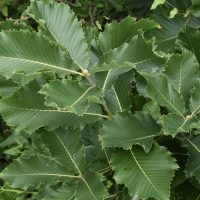Selections from the New Zealand Garden at the Washington Park Arboretum

1) Coprosma propinqua Mingimingi
Coprosma is a genus of about 90 species of shrubs and trees found in various Pacific regions, including New Zealand and Australia. They range from trees to low-growing spreading shrubs and those with a divaricating habit.
A member of the plant family Rubiaceae, C. propinqua is found in swampy areas and near streams throughout New Zealand. The leaves are very small and oblong and the berries are a translucent blue color.
“Barking up the Right Tree”

1) Stewartia monadelpha Orange Bark Stewartia
Stewartia monadelpha is a small tree (up to 25 feet high) with stunning cinnamon bark.
A member of the Camellia family, the white flowers resemble those of small, simple Camellias and can be viewed in early summer.
Several beautiful specimens can be viewed at the southern end of the Camellia Collection.
2) Lagerstroemia indica x fauriei ‘Muskogee’ Muskogee Crepe Myrtle
This garden hybrid was developed by the National Arboretum in Washington, D.C.
Read moreOctober 2020 Plant Profile: Blechnum penna-marina

Despite not having showy flowers this demure evergreen fern deserves to be grown in more Northwest gardens.
Read moreSelected Cuttings from the Washington Park Arboretum and the Garden of Virginia L. Morell

Virginia L. Morell was an avid gardener, president of the American Holly Society, Arboretum Foundation board member, and volunteer at the Washington Park Arboretum. Virginia and Jean L. Haigh started the Arboretum ‘Saplings’ Program, which they ran for two years. This program was taken over by UW Botanic Gardens Youth and Family Education and now serves thousands of school children each year.
Read moreSeptember 2020 Plant Profile: Mahonia (Berberis) gracilipes

This noteworthy shrub has unusual flowers, bold leaves and a tidy habit. Why not grow it in your part-shade garden?
Read moreMore Summer Specials at the Washington Park Arboretum

1) Clerodendrum bungei Rose Glory Bower
Rose Glory Bower (of the Lamiaceae family) is native to China and northern India.
This shrub spreads aggressively by root suckers and has become invasive in the South.
The rosy-red flowers are very showy and fragrant and attractive to butterflies.
You can find Clerodendrum bungei along Azalea Way below the Winter Garden.
2) Hydrangea serrata ‘Blue Bird’ Blue Bird Hydrangea
The Blue Bird Hydrangea was an Royal Horticulture Society Award of Merit winner in 1960.
Read moreSummer Specials at the Washington Park Arboretum

1) Fuchsia magellanica Hardy Fuchsia
The stunning display of pink flowers currently on Fuchsia magellanica are enjoyed by hummingbirds and humans.
This widely cultivated small ornamental shrub is native to Argentina and Chile.
You can find this and other Fuchsia sp. blooming in the Pacific Connections Garden.
2) Lagerstroemia ‘Natchez’ Natchez Crape Myrtle
An attractive small deciduous tree with slender, mottled stems.
Read moreAustralian Inspiration at the Washington Park Arboretum

1) Ozothamnus rosmarinifolius ‘Silver Jubilee’
The silvery foliage serves as a lovely backdrop for the dense clusters of white flowers in spring.
This shrub can grow to about four feet tall and wide and is a member of the Asteraceae family.
You can find Ozothamnus rosmarinifolius ‘Silver Jubilee’ blooming in the Australian portion of the Pacific Connections Garden.
2) Callistemon pityoides (Mt.
Selected Cuttings from the Home of UW Botanic Gardens Horticulture Manager, David Zuckerman

1) Buddleja globosa Orange Ball Buddleja
This Chilean large and lanky quasi-evergreen shrub comes true to name when in flower.
It is now festooned with 8-10 fragrant orange ball-shaped flowers arranged in terminal panicles.
Hummingbirds are fun to watch while hovering and feeding over each “ball” for several seconds.
You can view several blooming now in our Pacific Connections Chilean Gateway Garden.
